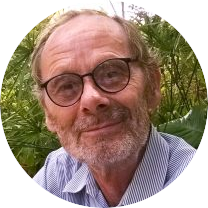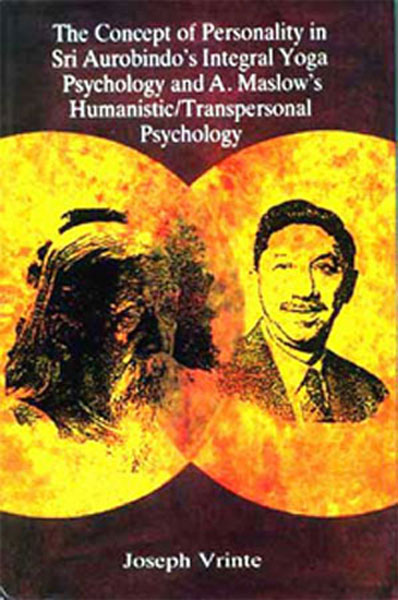 |
Details of the BookName:The Concept of Personality in Sri Aurobindo’s Integral Yoga Psychology and A. Maslow’s Humanistic/Transpersonal Psychology Page: 224 – ISBN: 81-215-0647-6 Price: INR 275 Cover: Hard bound |
|
Edition: 1995 Publisher: Munshiram Manoharlal Publishers Pvt. Ltd. Buy at http://www.amazon.com Select Books and search for Joseph Vrinte Buy at http://www.addall.com |
|
ABSTRACT
The aim of this work is, in the first place, to make a comparison between the psycho-logical insights underling Sri Aurobindo’s Integral Yoga and the Humanistic and Transpersonal psychologies developed by Abraham Maslow, together with their respective views on the various levels of human consciousness; in the second place, the intention is to pinpoint and reveal hitherto unexplored features in the works of both – a very extensive task of which only a little has been done – with reference to the writings of some other authors who have interpreted the psychological aspects of either Sri Aurobindo or Abraham Maslow.
In attempting to measure some of the basic postulates of these two thinkers it is essential to bear in mind that the psychologies of Sri Aurobindo and Maslow are founded on two different kinds of knowledge. Both based their psychology on authentic experience, but Sri Aurobindo expressed his insights largely in the language of Indian metaphysics, while Maslow used the Western empirical approach, struggling with the language of science.
Maslow’s metaphysical assumptions do not go beyond the intellect; they are based on speculations about the ultimate reality and have only limited spiritual value. For Sri Aurobindo, it is only by going beyond mind that each of us can contact and know the ultimate reality; only spiritual intuition and experience can reveal the nature of truth. Intellectual thinking, as an instrument for expressing the nature of truth, comes in only secondarily, as a judge of generalised statements drawn from supra-intellectual experience.
Throughout this work we are dealing with two different but often overlapping philosophies, and a crucial element in this comparison is the language that each employs. It is not immediately evident at any given point whether an apparent similarity or opposition in their views is a matter of ideas or simply of terminology.
Sri Aurobindo, born in the 19th century and educated in the classical tradition of the Occident as well as self-educated in the tradition of his native cultural heritage, employs the English of the intelligentsia of his time supplemented by the specific terminology of the Hindu tradition, sometimes in the original Sanskrit and sometimes in various translations.
Maslow, on the other hand, although he had read a great deal on eastern thinkers, was a citizen of the United States of America, where the development of language was diverging from the British mainstream. He thus employed a syntax and nomenclature which was far more idiomatic, colloquial and immediate in its impact than that of his predecessors in the field of psychology: his language had almost nothing in common with the language of Sri Aurobindo, classical scholar and mystic seer in the Hindu tradition.
It should be emphasised here that this thesis is not a comprehensive study of the complete works of the two thinkers, but rather a critical survey of some of their points of agreement and divergence; care has been taken not to lose sight at any point of what is essential in their respective visions.
FOR MORE TEXT, CLICK HERE
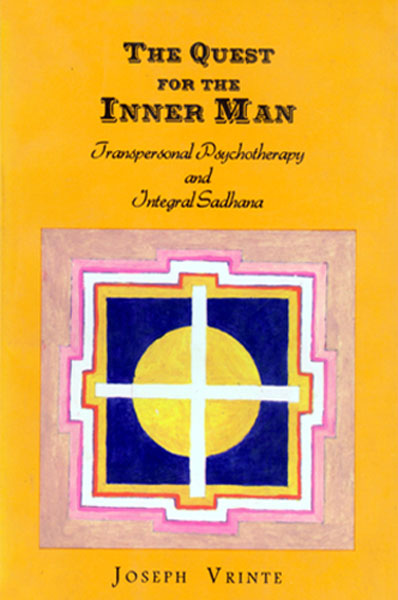 |
Details of the Book Name: The Quest for the Inner Man: Transpersonal Psychology and Integral Sadhana Page: 282 – ISBN: 81-208-1502-5 Price: INR 200 Cover: Paperback |
|
Edition: April 1996 Publisher: Motilal Banarsidass, New Delhi, INDIA Buy at http://www.amazon.com Select Books and search for Joseph Vrinte |
|
ABSTRACT
Transpersonal psychotherapy is characterised by the acceptance of the spiritual and cosmic dimensions of the personality, and the possibility of the development of higher states of consciousness. The transpersonal psychotherapist examines the negative influence of psychological conflicts on spiritual development, and the positive influence of spiritual practices on intrapersonal and interpersonal conflicts.
By including spiritual development in the therapeutical level the transpersonal psycho-therapist moves towards the dynamic process of self-transcendence where the individual is seen against his cosmic background.
Sadhana, the spiritual practice or discipline of Yoga, is related to the gradual unfoldment of the divine consciousness present in each and every being and which ultimately leads to the Divine life. Sri Aurobindo’s integral sadhana aims at the growth of a new consciousness and new inner life in which the surface personality, if looked at from the true and larger consciousness, becomes an instrument for its own perfection.
It is not an escape from the world to God, but a transformation of the seeker’s integral being into the terms of God-existence, i.e., to transform one’s entire being into God, ‘so that in a sense God Himself, the real person in us, becomes the Sadhaka (spiritual practitioner) of the Sadhana’.
In this critical survey the author tries to reveal unexplored features of two different but often overlapping approaches.
It is not always evident whether apparent similarities or divergences in their views are a matter of ideas or simply of terminology, and this work attempts to give the reader a clear insight and a deep appreciation of their respective psychological views.
FOR MORE TEXT, CLICK HERE
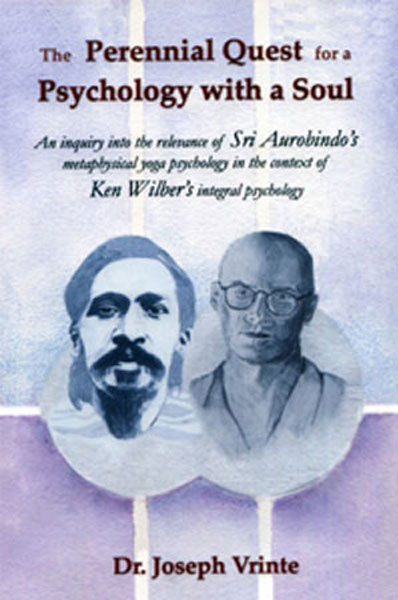 |
Details of the Book Name: The Perennial Quest for a Psychology with a Soul : An inquiry into the relevance of Sri Aurobindo’s metaphysical yoga psychology in the context of Ken Wilber’s integral psychology Page: 568 – ISBN: 81-208-1932-2 Price: INR 895 Cover: Hard bound |
|
Edition: 2002 Publisher: Motilal Banarsidass Buy at http://www.amazon.com Select Books and search for Joseph Vrinte |
|
ABSTRACT
This work aims at creating an impetus for a wider and richer understanding of Sri Aurobindo’s and Ken Wilber’s views, without jumping to general conclusions concerning ‘essential’ differences and ‘ultimate’ identities; it endeavours to maintain the autonomy and multi-dimensional richness of each discipline. The reflections and critical comments aim to analyse and to clarify various discrepancies between them. The author does not assert the superiority of one view over the other and does not want to argue whose thought is the correct one. He goes beyond allegiance to any one approach, as each model contributes something of value to the understanding of the complexity of Being. The author has broad sympathy with the aims and intentions of both thinkers, and tries to supplement this sympathy with a critical impartiality.
The subject matter of this book is so vast that it would be presumptuous to attempt to deal with it comprehensively and it would be pre-posterous to pretend a final solution to a set of ideas as comprehensive as these worldviews. The author is aware that the contents of this comparative study may appear offensive to the followers of Sri Aurobindo, or be interpreted by Ken Wilber as a mis-representation of his works, but this study only aims at indicating some possible potentials of both integral thinkers that are not being utilised. He tries to stimulate a fruitful dialogue and evaluates this dialogue in a sympathetic manner when he refers to the intentions of both thinkers.
FOR MORE TEXT, CLICK HERE
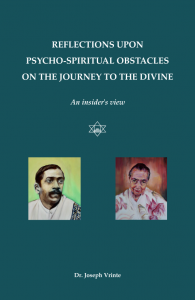 Details of the Book Name: Reflections upon Psycho-spiritual obstacles on the journey to the Divine
Details of the Book Name: Reflections upon Psycho-spiritual obstacles on the journey to the Divine
Page: 385
Price: INR 699
Cover: Paperback
Edition:
Publisher: Auroville Press Auroville 605101 TamilNadu India
Buy at [email protected]
Content: click here
ABSTRACT
This book is offered as an explorer ’s source book in the mapping of various psychological problems inherent in the practice of Sri Aurobindo’s integral sadhana. There are possible dangers in working with spiritual and psychological domains simultaneously and the various pitfalls are extensively elaborated in this book, because knowing about them can lessen the dangers. Questions and critical notes are not written in a mood of despair or frustration and they are certainly not meant as a criticism against the devotees of Sri Aurobindo and the Mother, on the contrary they are questions that entered the mind of the author during his research-work and long connection with the Ashram and thereafter living in Auroville for the last twenty-two years.
The author could not have asked these questions personally to Sri Aurobindo because the latter left his body when the author was just born, and later on he never came “in silence” to the author to answer these questions. The questions are not merely based on an academic, theoretical analysis, but they are as much related to the author ’s experiences, reflections, observation and perceptions during his practice, using it as a means to organise, understand and comprehend them in the light of Sri Aurobindo’s metaphysical vision. The author, as a scholar-practitioner, while attempting to practice the discipline of this study, navigates his way through various difficulties most seekers are confronted with during their practice, either in the beginning or later on.
Logical thinking, considering all sides of a question, is part of mental training. However, when the condition in sadhana is interrupted and the mind becomes agitated and gets restless, it begins to ask questions. In this situation the old mental sceptical questioning rises up, creating doubts and errors. For Sri Aurobindo, a growth in deeper and wider consciousness and experience will answer more mental questions than the argumentative questioning of the external mind and its ideas. To reach that the mind must be quiet and make place for intuition where the sadhak receives automatically the true answer. Nevertheless, the tendency to inquire and the development of the mind is in itself not wrong as long as these questions become a means for growth and progress. Sharpening the thought process supplements an increased depth in understanding and widening one’s vision.
As such, the author does not present the works of Sri Aurobindo and The Mother in a closed version, but he studies their texts in a more open way, and in the context of the present-day actualities. Though the truth of Sri Aurobindo’s philosophy has only theoretical value when it can be lived, the author experienced an absence of a healthy culture of dialogue and non-existence of an open discussion within the Auroville community about rational and experimental questions related to the psycho-spiritual obstacles and pitfalls during the practice of sadhana. Answers to these questions necessarily invite dialogue, and as such these questions themselves are for the author direct and unavoidable. It is only an open-ended dialogue about this issue that prevents the creation of dogmatic views, and stimulates a plural approach to the same goal.
Does Auroville need a more dialoguing community, where dialogue is the soul of Sri Aurobindo’s and the Mother’s vision, and where collective self-knowledge urges devotees to experiment, question and share with each other the search for truth?
As part of the path of knowledge the author has used a psychological analysis of self-reflection and self-observation, and used this as an effective introduction towards the inner centre of his being; in this attempt he tried to remove various obstacles rather than arrive at the final result of his sadhana. For Sri Aurobindo, intellectual deliberation and right discrimination are, though limited yet an important preparatory part of theYoga of Knowledge, they will lead to self-knowledge of a certain kind and right understanding. He maintains that “the intellect, though not a sufficient guide in the search for spiritual realisation, yet it has to be utilised in the integral movement of one’s nature. The seeking intelligence has to be trained to admit a certain large questioning, an intellectual rectitude not satisfied with half-truths or approximations. A working faith of the intellect is indispensable, not a superstitious, dogmatic or limiting credence attached to every temporary support or formula.”*
For the author, an analytical and synthetic approach need not be irreconcilable opposites, they may function as complementary processes; a synthesis which combines various components into a new whole needs an analysis first. The author does not claim to have great spiritual experiences, he only attempts to share with the reader questions related to various aspects of Sri Aurobindo’s Integral Yoga, though these questions may not always result in clear answers; some of these questions related to the subjective, introspective experiences are, therefore, debatable and open for discussion.
Does Sri Aurobindo’s vision provides room for a dialogue around critical issues, and is a sophisticated debate useful for the followers of Sri Aurobindo and the Mother during the practical day to day affairs in a rapidly changing world? The object of this debate in this study is not merely for the sake of winning a logical, intellectual exploration of arguments in order to successfully explain the author’s views, on the contrary, a debate concentrating on the pursuit of truth may become richer if there are more perspectives taken in consideration, because the absence of a healthy culture of debate and intellectual apathy do not contribute anything in the search for the validity of Sri Aurobindo’s and the Mother’s spiritual views.
Sri Aurobindo’s metaphysical views are not always easy to understand for the beginner practitioner and in order to get a better idea of the complexity of Sri Aurobindo’s vision the author repeats certain issues discussed in the first couple of chapters again in the final chapters, by using a slightly different language and using them in a different context.
Before analysing the various questions related to the difficulties during the practice on the journey to the Divine, the reader is advised to get acquainted with some of the basic theoretical concepts of Sri Aurobindo’s metaphysical vision, his metaphysical Yoga psychology and various aspects of Transpersonal psychology
as explained in the first chapters of this investigation.
*The Synthesis of Yoga. p 777.
This book comprises of two parts, sub-divided into six chapters, an Epilogue and Post-script.
Part I – Sri Aurobindo’s metaphysical vision
Chapter One on Metaphysical principles in contemplative Psychology gives some background information for the other chapters, and discusses various aspects of the nature of spiritual discipline.
In the psychological nature of spiritual discipline, the author shows that all traditional spiritual disciplines aim at clarifying the contents of consciousness and through spiritual practice they aim at an opening to the more spiritual contents of consciousness. Spiritual discipline is concerned with the immediate actual experience, often muted, of the seeker’s own awareness in the exploration of consciousness. An increased self-awareness and extended awareness of life’s possibilities enable the seeker to venture into new and unknown paths. The reality that underlies the world of appearances is accessible to mystical intuition, and the experience of this underlying reality clarifies the true nature of the self and gives meaning to the aim of life.
In the next part of this chapter on the metaphysical nature of spiritual discipline, an explanation is given about the limitations of science in relation to metaphysics; though science lacks contemplative introspection on the deeper aspects of the absolute Truth, yet logical reasoning, as a partially enlightened guide, is part of the preparation for the method of metaphysical investigation. The limitations of science can be removed through contemplative introspection on the deeper aspects of life and the absolute truth within the soul. There are rational explanations for spiritual experiences, the direct experience of the innermost reality, even though reason is not always the best way to study them.
Chapter Two
Without briefly explaining some of the main features of Sri Aurobindo’s metaphysical background in the second chapter, his comprehensive theoretical system and his emphasis on the practical implications for human life, it becomes difficult to evaluate his views regarding the ideal of a spiritual human life. Sri Aurobindo’s metaphysical vision and claims are grounded in his spiritual practiceand in the realisation of his reproducible spiritual experiences. Metaphysical reasoning should establish its generalisations from spiritual experiences and on the basis of that experience together with the seeker ’s own evidence, it arrives at a supreme proof in which the reasoning intellect comes in only on the second line as a judge of the generalised statements drawn from the experience. The pursuit of metaphysical truth ought not to be merely an intellectual pastime, but a discovery of the basic truths of all-existence by all right means. Due to this reason are the concepts of metaphysical knowledge not satisfying the integral man until it becomes an experience.
The author offers in this chapter a brief explanation on the spiritual evolution in the context of Sri Aurobindo’s metaphysical vision.
Chapter Three;
In the third chapter on the main issues of Sri Aurobindo’s Metaphysical Yoga Psychology the author elaborates, in more detail, on Sri Aurobindo’s two main works which are often used by commentators, and his “Letters on Yoga” which were, and still are, an important guidance for the seekers who were in written contact with Sri Aurobindo. After discussing the aim of integral Yoga, the author continues this chapter with an explanation on Sri Aurobindo’s process of integration, transformation and the triple transformation.
The experience of the psychic being plays an important and essential role in the sadhak’s journey to the Divine and will, therefore, be explained in more detail due to its psycho-spiritual importance. In “preparatory means as the foundation of the sadhana”, the cultivation of equality, aspiration and surrender as the preparatory means makes the lower nature, mind, life and body, fit instruments for the divine works. The lower instrument must not only be purified but also raised to a capacity for a greater action of the Divine Power. The passage from the human to the divine need, together with the preparatory stages, an actual illumination and realisation in the prepared soul by “the three constituent elements” of Yoga in sadhana; purification, liberation and perfection. The cultivation of these three elements with thepreparatory stages together makes the nature a fit instrument for the divine works.
Chapter Four;
Most of the contents of the fourth chapter are copied from the author’s previous publication “The Perennial Quest for a Psychology with a Soul”, in which he discusses various aspects of the Transpersonal movement, and compares the transpersonal views with Sri Aurobindo’s Metaphysical Yoga Psychology.
Though this chapter has been written almost twenty years ago, the contents are still very useful and applicable for this study and therefore added to this work. Sri Aurobindo’s Yoga Psychology, as a scientific study that is concerned with the actual workings of the mind and consciousness, must be comprehended by a metaphysical study that is related to the nature and the cause of the ultimate reality. Its methods include the subjective intermittent data of self-observation and the nature and movements of consciousness as they are revealed to us by the process and results of our yogic practice. Sri Aurobindo emphasises exact observation and scrupu lous experimentation as the true method of a scientific psychology. Such a direct experimental and experiential psychology must replace the mass of elementary and superficial generalisations of the empirical system.
Thereafter, the author explains in brief the main issues of Transpersonal Psychology, Transpersonal Psychotherapy and Psychiatry, and continues to compare various aspects of Transpersonal Psychotherapy with Sri Aurobindo’s sadhana, and finishes this chapter with the role of the Ego in Transpersonal Psychology and Sri Aurobindo’s Yoga Psychology, and the place of psychopathology in sadhana.
Part II – Sadhana in Interal Yoga and its difficulties
Chapter Five;
After explaining the term sadhana, the author gives a detailed overview of the various difficulties in each part of the being-the physical, vital, mental, subliminal consciousness and during the psychic, spiritual and supramental transformation. Sri Aurobindo’sintegral sadhana is not an easy practice, and he explains that the goal of Integral Yoga is more difficult than any other Yoga. It is for those who have the call, the capacity, the willingness to face everything and every risk, even failure. Everybody can do some kind of Yoga according to his or her nature, “but there are few of whom it can be said that they have the capacity for this Yoga”. It is only for those who accept to seek its aim, and proceeds by the aid of faith and the guidance of the Guru.
However, in the sunlit path the spiritual optimist is able to meet the difficulties without much pain and despondency. The seeker is advised to turn his eyes to the light and less to the darkness.
Grace plays an important role in the practice of sadhana and is an essential part of the sunlit path. Though the seeker is not able to merit Grace, yet one is able to develop capacities in order to receive it. To try to overcome the forces of the lower nature only by one’s own efforts may end in disaster; it needs simultaneously the descent of Grace.
Chapter Six;
The sixth chapter, on concluding reflections, attempts to give a critical evaluation on various aspects of Sri Aurobindo’s integral sadhana.
In his metaphysical views, Sri Aurobindo uses the method of direct self-observation, spiritual experience and intuition to study the inner functioning and purpose of the sadhak’s behavior, but does this view pay sufficient attention towards determinants of outer circumstances, such as cultural and value difference, the historical, social and traditional context, biological heredity factors and childhood history? To answer this question, the author elaborates on the merits and demerits of the role of ethics in sadhana.
Are such ultimate views on ethics something inhuman or rather hardly human? It depends, as the author will explain. Thereafter, he critically comments in detail on the function of the Guru and Grace in sadhana. Is Sri Aurobindo a traditional Guru or a phase-specific authority who guides the devotees during the awakening of their true self, after which his authority as a Guru diminishes? Does he ask thesadhak’s unconditional support in his metaphysical vision, or does he want the sadhak to have faith in the spiritual meaning of his integral sadhana? Each sadhak has some power to accelerate the realisation of the changes in humanity necessary for a divine life, but Sri Aurobindo emphasises the primary importance of the Divine Grace, which is almost exclusively responsible for the future spiritual evolution. But is it only Grace which can do what the sadhak cannot do? In the final part of this chapter the author raises various questions related to the, at times, difficulties associated with the experience of the psychic being. The author elaborates extensively on the various pitfalls and obstacles of the psychic experience which may occur during the practice of sadhana.
Epilogue
In the Epilogue the author creates a dialogue between modern day scientists and Sri Aurobindo, and explores in detail the scientist’s technological interference in future human evolution in the light of Sri Aurobindo’s metaphysical principles of spiritual evolution. Sri Aurobindo associates rebirth as a means for spiritual evolution. Rebirth implies a psychic theory of heredity; this psychic heredity need not always be reduced to physical aspects as maintained by natural science, but includes also Samskaras – impressions from past habits which are stored up in the unconscious; it is the soul which chooses its own destiny in the future by means of karma, in other words there is a soul evolution next to physical evolution.
However, could it be that technology, virtual reality and artificial intelligence are new ways of representing the supposed truth of Sri Aurobindo’s future evolution and his vision of the Divine life? Are present-day developments and research by scientific investigators on “future designer babies”, with the help of the CRISPR-Cas technology, the resurrection of the soul and the genetically mixed children from the laboratory the new humanity? Is the scientist victim of an enlarged ego who is suffering from self-deception, or is the same scientist the solution of the future evolution and is this the way for the greater race towards a form of life that is nearer to the Divine?
Post-script
The author attempts in the postscript to relate some of the questions of his analytical research to the present-day situation in Auroville, the city where he got the chance to observe the complexities of the spiritual multicultural experiment, and to investigate them against the background of Sri Aurobindo’s and the Mother’s vision.
What will happen to those Aurovilians without sufficient preparation and without understanding the phenomenon, and about those who are psychologically not ready for the experiment due to lack of discipline? Who will guide all those Aurovilians to navigate through the various confused parts of their being? Does the Auroville community encourage its citizens enough in questioning the various, sometimes deep-rooted, difficulties and its consequences, which are inherent during the practice of sadhana, and where each Aurovilian, sooner or later, will be confronted with? Could it be that though the Aurobindonian end is driven by divine supramental ambitions, which keep the devotee on the slippery path of spiritual practice, that this firmness of purpose degenerates into obstinacy when errors in the practice of the devotees are not recognised, reconsidered and redressed?
Taken out of its context the Mother’s words might be easily misunderstood when Aurovilians confuse their difficulties related to the indulgence of their undesirable psychological character defects that come to the surface (fear, ambition, power), with the psychological difficulties Aurovilians encounter while in contact with the psychic consciousness, where the psychic being is in front.
Is the utopian dream with its unbounded expectations an ideal of the past and is Auroville moving in a different direction as was given by the Mother? Are some present-day Aurovilians able to identify chronic blockages of development in the community and able to envision a new direction towards Auroville’s fundamental spiritual ideals and values. A collective lived value system evaluated in detail and integrated in the goal of the community may be able to counter the rampent power, ego and injustice which affects fellow devotees who are struggling to transform themselves in Auroville’s experimental movement. Maybe it is necessary that the community considers giving support to a process which surfacesAuroville’s collective wisdom in order to restore its direction and bring the Aurovilians together again? Now that the City is gradually growing and problems become more complex, should Aurovilians maybe also learn something from the experiences elsewhere in the world? In what way will Auroville collaborate with the latest developments in new knowledge emerging around the world, and in what way does Auroville use and take advantage of this knowledge into the Auroville experiment? The dynamics of the increasing digital globalisation has its consequences for progress, but how does Auroville avoid the negative aspects of the digital globalisation process into its collective experimentation for a more integral progress of humanity? What about the implementation of parts of the existing system which we all know works effectively and work first from that basis onwards to a more appropriate direction? Is Auroville ready to confront its shadow, individually as well as collectively, as in difficult times a moment of truth often occurs where policy and opinions make way for decisive changes?
